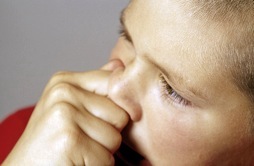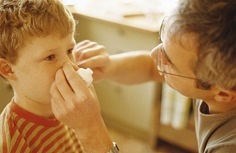-
Emergency Conditions / First Aid




Objects in the Ear or Nose
A foreign object stuck in an ear or the nose needs to be removed. If not, an infection could result. Damage to structures in the nose or ear could also occur.
Signs & Symptoms
A child may be able to tell if an object was put in a nostril or an ear and didn’t come out. If not, signs and symptoms can help identify this problem.
For an Object Stuck in an Ear
-
•Feeling of fullness in the ear.
-
•Ear pain or discomfort.
-
•Hearing loss and/or feeling dizzy.
-
•Foul odor from the ear and/or drainage from the ear.
-
•Bleeding from an ear.
For an Object Stuck in the Nose
-
•Constant nasal discharge from one nostril.
-
•Foul odor. Pus or blood drains from a nostril.
-
•Pain, swelling, and/or tenderness.
Causes
-
•An object or substance is placed in the ear or nose on purpose and won’t come out.
-
•Objects get stuck in the nose or ear by injury or by accident.
-
•An insect flies or crawls into an ear.
Treatment
Medical care is needed for foreign objects that can’t be removed with self-care. After an object is removed, an antibiotic may be needed if an infection is present. Small, button-sized batteries need to be removed to prevent burns.

Young children like to put things in their mouths, ears, and nose.





To Remove Objects in the Nose
-
•Don’t use a sharp tool, cotton swab, etc. to try to locate and remove the object.
-
•Breathe through the mouth until the object is removed.
-
•Apply gentle pressure to close the other nostril and gently try to blow the object out.
-
•Remove the object with blunt tweezers, if it is easily seen and can be grasped and pulled out.
To reduce swelling, spray a nasal decongestant in the nostril with the foreign object.
Self-Care / First Aid
To Remove an Insect from an Ear
-
•Kill the insect before you try to remove it. To do this, tilt the person’s head to put the ear with the insect in an upward position. Pour warm (not hot) mineral, olive, or baby oil into the ear. As you pour the oil, straighten the ear canal. In a child, pull the earlobe gently backward and downward; backward and upward in an adult.
-
•The goal is to suffocate the insect and cause it to float out.
To Remove Objects Other Than Insects
-
•Don’t use oil.
-
•Tilt the head toward the side with the foreign object. Gently shake the head toward the floor to try to get the object out. Do not shake a baby. Gently pull the ear up and back.
-
•Don’t use a sharp tool, cotton swab, etc. to try to locate and remove the object. This risks pushing the object farther into the ear. Doing this could damage the middle ear.
-
•Remove the object with blunt tweezers if it is easily seen and can be grasped and pulled out.
Do any of these problems occur?
-
•Hearing loss or feeling dizzy.
-
•Signs of an infection, such as fever, pain, swelling, foul odor, pus drainage, etc.
-
•An insect cannot safely be removed from an ear.
-
•After several tries, an object cannot be removed from a nostril or an ear.
Do any of these problems occur?
-
•A sharp object is stuck in a nostril or ear.
-
•An object stuck in a nostril or ear causes severe pain or a lot of bleeding.
-
•Removing an object from a nostril caused a severe nosebleed.
-
•A button-size battery is stuck in a nostril or ear.
Questions to Ask





Copyright © 2009, American Institute for Preventive Medicine. All rights reserved.